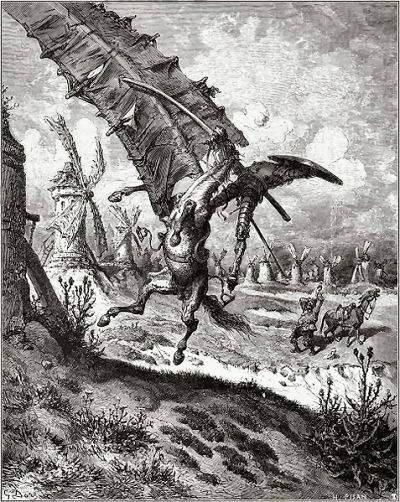
We are entering can era of severe scarcity
Illustration: Gustave Doré's Don Quixote
We are entering can era of severe scarcity in which centralised and globalised systems will fail to provide for us and we will have to develop highly localized economies. Most people would probably doubt that we could organize satisfactory communities without vast state bureaucracies and corporations. The achievements of the Spanish Anarchist workers collectives in the 1930s show what miracles ordinary people can do.
One of the strong beliefs reinforcing the acceptance of consumer-capitalist society is the assumption that it has to be run by authorities up there somewhere, by governments, bureaucracies, corporations, experts, CEOs, via big complex systems that ordinary people like us can’t fathom and couldn’t possibly run. People take it for granted that there is a vast distinction between our governors and we who are governed, and this is inevitable in a modern complex technocratic society. Our only role in government is to elect our governors occasionally, then submit to their rule. Meanwhile it is best if we devote ourselves to working diligently, consuming, football, celebrities and trivia.
In my very firm view consumer-capitalist society will soon be over. It is extremely unsustainable and unjust. There is no possibility that the per capita rates of resource consumption the 1.5 billion rich have can be extended to the other 7.5 billion we will soon have on earth. The Australian footprint of 8 ha of productive land per capita is about 10 times the area that will be available per capita in 2050. Well before that we will run into savage and insoluble shortages of oil, water, food, fish, several minerals, phosphorus, and the ecological consequences of the greenhouse problem, destruction of soils and forests, and a holocaust of species loss, the social and political impacts of collapsing states, resource wars and massive refugee movements.
Globalisation is over
Whether we like it or not we will localize. Globalisation is over. If complete collapse and die-off is avoided the only viable path will be in terms of mostly small and self-sufficient local economies in which people cooperate to organize their own local productive capacity to produce for themselves most of the things they need with little trade. In the coming age of severe scarcity economies must be mostly focused on needs and not profits, and organized by rational and cooperative control of the economy as distinct from driven by market forces (although they could still have a role.) Above all there can be no economic growth at all, and affluent “living standards” must be abandoned. The goal must be satisfactory but frugal and self-sufficient ways in stable or zero-growth economies.
Most people would probably totally reject this vision, believing that conservation effort and technical advance will enable us to go on pursuing ever-increasing affluence and GDP. In addition they would not believe that an acceptable alternative defined in terms of frugal living standards and no growth could remotely be designed. However I have no doubt that we could easily and quickly build a very satisfactory as well as sustainable and just society…if we wanted to. Its principles would have to be frugal but adequate living standards, high levels of self-sufficiency in mostly small local economies of the kind indicated above. (For a detailed discussion see The Simpler Way website, .) In my view this is the direction we will be moving in soon, whether we like it or not.
Again l think one of the most powerful ideological forces blocking such a transition is the general conviction that a satisfactory society could not be run without all those heavy bureaucrats, experts and CEOs, and rule by authoritarian and complex governments. Well if that’s your view, let me tell you about what the Spanish Anarchist collectives did in the 1930s.
The Spanish Anarchist Workers Collectives
In a period of about six years after 1933, during a civil war, the anarchists got control of large areas of Spain, containing 8 million people. Possibly 1800 collectives were established. Often they were able to take over factories and estates abandoned when their owners fled the war. With remarkable speed collectives made up of workers in these firms formed and organized to continue production. Many very large ventures were quickly put back into operation. For instance three days after a battle in Barcelona the trams were running again.
Attention was focused on the most important needs, for instance the setting up of communal dining halls. The collectives plunged into the reorganization and improvement of industries, for instance combining many previously struggling small firms, coordinating and integrating. In some regions they ran the fishing industry, from the boats to the canning factories and the distribution networks. They actually organized and ran whole regional economies, including public services such as policing, road construction, flood control, water supply, transport, maintenance of parks. They set up banks, flour mills, theatres an aluminium industry, organized international importing, printed their own money, abolished interest payments, and ran railways and telecommunications systems. Entire health systems were established, including medical centres, hospitals and sanitoria. In Barcelona six hospitals and eight sanitoria were built. Dental services and surgery was free, provided by doctors receiving set payments. Schools were free. Ordinary people gained access to medical services they previously could not afford when doctors only served the rich. They even established engineering and optical training institutes, and a university. The city of Barcelona with a population of 1.2 million was run in these ways.
Towns exchanged surpluses. Some towns and collectives abolished money, arranging all production and distribution in terms of needs and vouchers. Abundant things, such as fruit in season, were free, but scarce things were rationed.
The basic format for this “governing” was the weekly assembly of all workers in the factory, reviewing all operations, planning, electing managers, making decisions. Factories would send delegates to meetings handling issues involving several factories, and similar delegations up to larger and more centralized assemblies would deal with wider regional issues. These latter gatherings had little or no power because recommendations would be taken back down to the factory assemblies where everyone had a vote. That’s the essential Anarchist principle; all power is held by citizens and any centralized issues are thought out by delegates but the recommendations are taken back to the citizen assemblies for approval. They refused to resort to bureaucrats, let alone paid or professional officials, managers or politicians. Managers were just more experienced workers elected by the assemblies, recallable at any time. Committees mostly met after work hours or on the weekend. In other words the government of factories, farms, industries and entire regions was actually carried out by ordinary people deliberating in citizen assemblies. Of course in all these domains more experienced people had key roles but were not bosses or privilelged.
From accounts such as those in Dolgoff, The Anarchist Collectives, (1973) the production of goods, the efficiency of operations, the effectiveness of distribution and allocation, and the social welfare and justice consequences were huge improvements on what had prevailed before when control was in the hands of privileged elites and most people lived in poverty and oppression. They reorganized and innovated extensively and quickly. Men and women became much more equal. Large transfers of goods were organised to poor towns, supplies to hospitals were quickly established. A voluntary retirement age of 60 was set. Unemployed people were paid a full wage. By bringing previously idle and inefficiently used productive capacities into operation huge surges in output and welfare were quickly achieved.
Where wages were retained they were made more or less equal. However in many industries wages were abolished, for ideological reasons. Wages are elements in the system where capital hires labour, controls production, and takes the product, and workers have no involvement in production other than selling their labour and they can be dumped at any time at the whim of the employer. Instead in some cases they simply organised to provide all workers with listed necessities, sometimes via voucher or coupon systems. These entitlements varied with need, for instance being greater if there were children in a family. Thus they implemented the basic “communist” principle of allocating according to need not work done or skill.
In his introduction to Dolgoff, Bookchin makes some important observations on the mentality of the industrial worker. A lifetime of taking orders, discipline to often mind-numbing grind, no control or responsibility or concern with the uses of the product or its social value or who benefits, is likely to produce passive consumers primarily interested in their wages, i.e., purchasing power. Workers tend not to think they should do any managing. It is not surprising that in Spain the alternative thrived most in the rural regions because in addition to the collectivist traditions, the peasant way of life involves conditions and dispositions that are foreign to the industrial worker. Small; farmers must be multi-skilled handymen, energetic, thoughtful and responsible. I believe the coming revolution will be led by the spirit of the peasant and homesteader. When your welfare depends not on a wage, but on whether you organise and manage and fix and plan and think ahead and troubleshoot, and plant the beans in time,…and maintain the cooperative relations with the people in your community you depend on…then you are more likely to have the dispositions Anarchism requires.
Marx didn’t grasp any of this. In my view Marx’s analysis of capitalism, how it works, why it has problems, where it is taking us, is of the utmost importance. But what he thought about the post-capitalist society and how to get to it are I think of little value or mistaken (apart from the principle “From each according to ability, to each according to need.) If we get through to a sustainable and just society it will not be via violent revolution led by the working class led by a vanguard party which will rule from the centre until we become capable of communism. None of that can lead to local economies run by local people in participatory ways. In addition Marxists still fail to see that a satisfactory society cannot be heavily industrialized or affluent. But what’s most important here, as Bookchin points out, Marx didn’t think the outlook and personality of the worker was important (except in so far as he would support revolution.) That could be left until after the revolution. All that mattered was harnessing workers to revolution. The Anarchists in Spain had a totally different view, realizing that everything depended on how aware, committed and autonomous ordinary people are. They put a great deal of thought and effort into developing what they called “personalities”. That’s our main problem now.
Achievements were more impressive in rural areas than in the urban and industrial areas. Many impoverished peasants were able to come into larger and more farms. They were not coerced to do this and many remained outside the collectives as independent farmers. These received surprising levels of assistance from the collectives, often enjoying the benefits they would have enjoyed had they joined. They were not allowed to own more land than they could work.
These achievements were made in difficulty conditions, with many able bodied people away at the front, produce sent from regions to the troops, and at times under destructive attack from enemies.
The material I have read does not throw much light on how they were able to coordinate things. How were they able to make sure that enough bolts of the right size turned up at the right factory when they were needed. Remarkably it seems that such things were sorted out well enough just by people organizing to get and send the necessary information and supplies. They did put a great deal of effort into collecting statistics to enable sound decisions, and into research to improve production.
The extremely important point for us in all this is that their achievements demolish the claim that you have to leave the mass of decisions to the workings of the market or to centralized state bureaucracies. They seem to have shown decisively that rational planning carried out by citizens can run an economy at least well enough. Remember that in the coming era our economies will be far less complex than they are now, greatly simplified by the absence of growth, making the control of small and local economies more tractable.
Note that although they did these things without huge professional planning bureaucracies. They did plan and make rational decisions, based on the detailed statistics they continually collected. But apparently they could quickly see what needed doing and then make the necessary decisions and carry them out via grass-roots assemblies and elected managers. Compare that with our bureaucracies where if you are lucky you get a letter back in two months.
So there, we can do it! Ordinary people can run economies via participatory democracy, without states, capitalists, bureaucracies or authoritarian rule.
As I see it Anarchism defines political maturity. For thousands of years humans have tolerated rule by kings, tyrants, dictators, and politicians. Representative democracy does not allow people to govern themselves. They are treated as infantile and untrustworthy. The goal must be citizens taking responsibility for running their own collective affairs directly, with no one having power over anyone else, via highly participatory procedures. In his discussion of the way this was done by the Ancient Greeks, the Medieval and New England towns, Bookchin stresses the educational significance of this, its importance for the development of mature, thoughtful, caring and responsible citizens. When your fate and that of your town depends on whether or not you can help make good decisions in the assemblies you have a strong incentive to develop conscientious thoughtful and caring dispositions.
So it’s a bit more complicated that I have made it appear to be at the start. I misled you by saying that in Spain “ordinary people” achieved all those things. The key to the Anarchist success is to be found in the long history and powerful ideological traditions of the regions. For hundreds of years rural villages had functioned in highly collectivist ways. In addition Bakouknin’s Anarchist theory had been brought to Spain in the 1880s and had been widely influential. The movement had grown significantly in the decades before 1930, so when the opportunity came with the civil war large and sophisticated pre-existing forces sprang into action. Ideas, values land practices that had been in existence and rehearsed for a long time could be quickly put into operation.
The point is that the remarkable achievements of the Spanish Anarchists were made possible by extra-ordinary people. We will not be able to do these things unless the right ideas and values have been widely established. People in consumer-capitalist society are far from the necessary state. Governments cannot do it for them. They cannot develop the new local participatory economies, firstly because they can’t think in any other than centralised, top-down solutions, free markets and capitalist control. More importantly, the required economies of The Simpler Way will by definition be run by the citizens of the town or suburb. Only they can learn their way to the procedures for doing this that suit their local conditions. We cannot begin down that path until people in general see that it is the way to sustainable and just society, and eagerly seek to take that path because they can see that it will yield a much higher quality of life.
We are sadly very far from having anything like the necessary ideology and values among the passive, trivia-preoccupied consumers of late capitalist society. That defines the task before those who want to help solve global problems. We have to work very hard to build the required world view, values, and commitments, and there isn’t much time left to do it.
How do we do it?
In my view the Left has always been remarkably weak on the nature of ideology and how to liberate people from the dominant ideology of consumer-capitalist society. Here are brief notes on how I think we should try, given the global situation we are in. (For a more detailed discussion see.)
Again we are in a historically unique situation because after hundreds of years in which increasing wealth and abundance were taken for granted we are likely to rapidly enter an era of permanent and intense. Especially as petroleum dwindles, people will realise with a jolt that the old systems will fail to provide for us and that communities will have to organise local economies. This is already happening, most inspiringly within the Transition Towns movement. By far the most important step that can be taken by anyone who wants to save the planet, prevent global warming, eliminate Third World poverty, bring peace to the world, etc., is not to join a green party, buy a Prius, lobby against wood-chipping, or learn how to fire an AK47. It is to come and help us start building aspects of the new society, here and now, within the towns and suburbs where we live. This is not just because those are the alternatives that must eventually be built. More importantly it is because working there side by side with ordinary people will give us the best possible access to build the necessary critical global consciousness, that is, to get people to understand that the old systems cannot be made sustainable or just, that vast and radical change is needed, that free markets, growth, competition and acquisitiveness must be scrapped, and that there are far more satisfactory ways.
Dolgoff, S., Ed., (1990), The Anarchist collectives : workers’ self-management in the Spanish Revolution, 1936-1939 ,Montréal, Black Rose Books.
Ted Trainer
6.6.09
 By Albert Bartlett
By Albert Bartlett
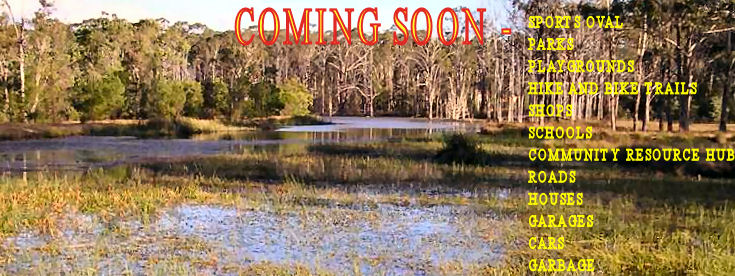

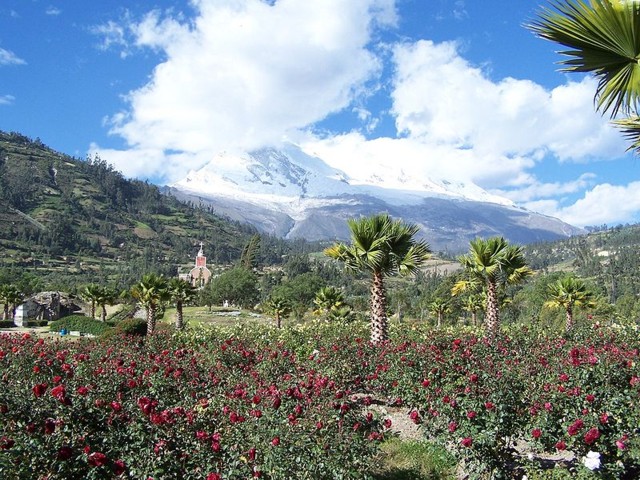
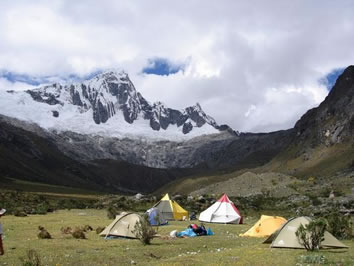

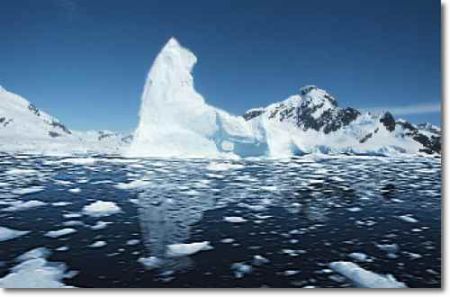


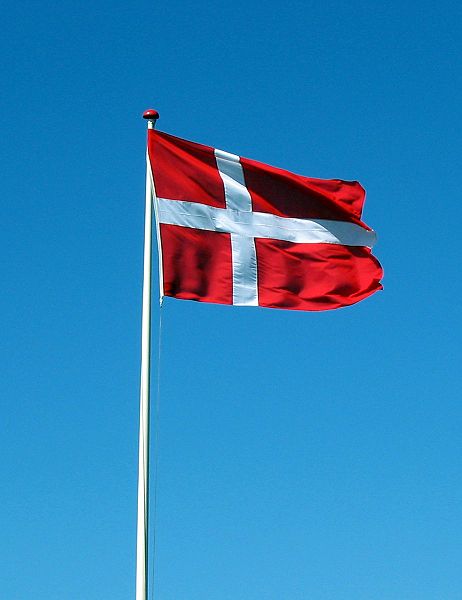

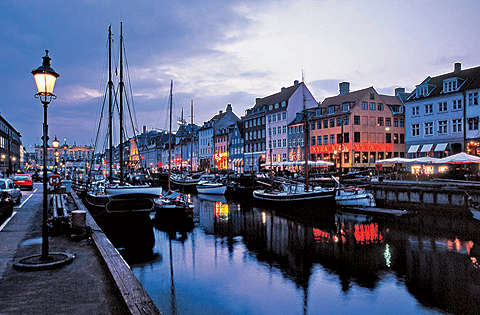
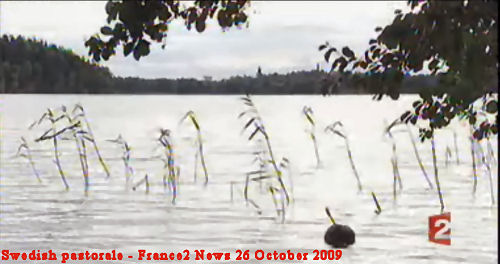

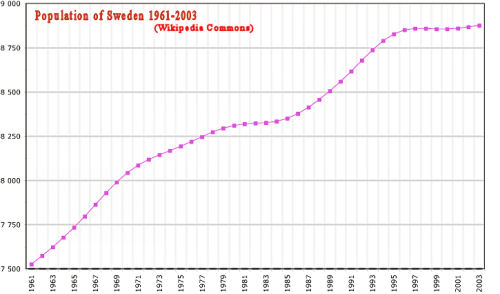




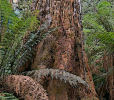 Article about Brown Mountain on the Anarchist media net says that the logging of Brown Mountain will be done by public servants who would be otherwise deployed in our poorly tended ecosystems if they were not sent off to log. However EEG disagrees on this point. See related important corrections to original article in comments below it inside. They also make interesting reading.
Article about Brown Mountain on the Anarchist media net says that the logging of Brown Mountain will be done by public servants who would be otherwise deployed in our poorly tended ecosystems if they were not sent off to log. However EEG disagrees on this point. See related important corrections to original article in comments below it inside. They also make interesting reading.


 Kelvin Thomson on Overpopulation in Australia and the World: Parliamentary Speech 17/08/09
Kelvin Thomson on Overpopulation in Australia and the World: Parliamentary Speech 17/08/09.jpg)
 click here for film
click here for film



Recent comments